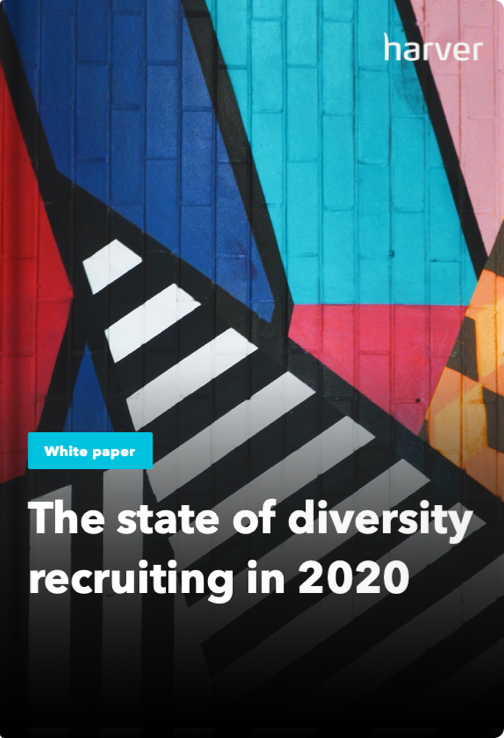You might think that your hiring practices are fair. You don’t discriminate against anyone, everyone goes through the same recruitment process, and you take great care to ensure there’s a level playing field for each potential employee.
The thing is, unfairness doesn’t have to be conscious. These days, it’s more often the result of unconscious bias rather than intentional discrimination. That’s exactly why you need to recognize adverse impact in your recruitment processes and take the right steps to minimize it as much as possible.
In this article, we share 8 different ways you can mitigate adverse impact, both in your hiring practices and beyond. Let’s get started!
What’s in?
- What is adverse impact?
- Why it is essential to prevent adverse impact
- How to minimize adverse impact in your hiring process (and beyond)
Like what you see?
Don’t miss out. Subscribe to our quarterly digest to get the latest TA and TM resources delivered right to your inbox.
What is adverse impact?
The Equal Employment Opportunity Commission (EEOC) defines adverse impact, which is also referred to as disparate impact, as “a substantially different rate of selection in hiring, promotion or other employment decision which works to the disadvantage of members of a race, sex or ethnic group.”
Adverse impact can occur in several different employment practices, including pre-employment assessments, job interviews, job advertising, promotions, training and development, layoffs, transfers, and even performance reviews. It can either happen within a specific step of a procedure or during the practice as a whole. In most cases, adverse impact is unintentional. For example, conducting strict criminal background checks without business necessity might have a disproportionate effect on members of a protected class.
Disparate treatment is another type of discrimination that occurs along with adverse impact. While adverse impact is considered indirect and unintentional, disparate treatment is an intentional form of discrimination. In other words, disparate treatment occurs when specific decision-making processes are proven to be intentionally discriminatory, such as separate pay scales for men and women in a similar position.
The EEOC has issued guidelines to help employers comply with federal regulations prohibiting practices that discriminate based on race, color, religion, gender, sexual orientation, and/or any other protected group.
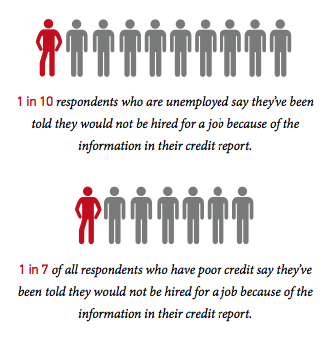
Credit check could be another example of a hiring practice creating adverse impact, denying jobs especially to people of color and individuals from low- and middle-income households.
Why it is essential to prevent adverse impact
Building an inclusive work environment through fair recruitment, employee development and promotion is a top priority for most employers today. Preventing adverse impact in (and beyond) your hiring efforts is essential for:
Ensuring fair hiring practices
Of course, you want to ensure fair hiring practices at your organization that level the playing field for your candidates. Identifying and mitigating adverse impact in your recruitment efforts is an important step you can take to ensure you’re providing each applicant a fair chance, regardless of their race, background, gender, ethnicity, religion, age, and sexual orientation.
Supporting legal defensibility of your recruitment process
It’s not enough to believe your hiring practices are fair—you have to be sure they’re legally compliant as well. Being compliant with the local laws and able to justify your candidate selection decisions supports the legal defensibility of your recruitment process, ultimately protecting both your business and your employees.
Improving diversity in the workplace
There are countless benefits to investing in diversity and inclusion in the workplace. Diverse companies not only have better financial performance and employee engagement, but also the ability to make more innovative, well-rounded decisions.
In fact, a Boston Consulting Group (BCG) survey revealed that companies with above-average diversity on their management teams also reported a 19% higher innovation revenue than those with below-average leadership diversity. Recognizing the benefits, an increasing number of employers are actively working to implement diversity initiatives in recruiting—and minimizing adverse impact is one way to do so.
How to minimize adverse impact in your hiring process (and beyond)
1. Conduct an objective job analysis
One of the first steps you can take to minimize adverse impact is to conduct an objective analysis to determine the specific requirements that are essential to perform each job. Make sure to focus on assessing the relevant skills and competencies your candidates will need to do the job they’re interviewing for, and that alone.
Your selection criteria should always be directly related to the job in question, otherwise, there’s a high risk of adverse impact. Here’s how David Barrett, chief commercial officer at Cut-E Group, explained the importance of this step:
“A high level of adverse impact will occur if the criteria that you use to select candidates are not related to job performance. If you’re not very clear about the qualities you require, unconscious bias will creep into your selection process.”
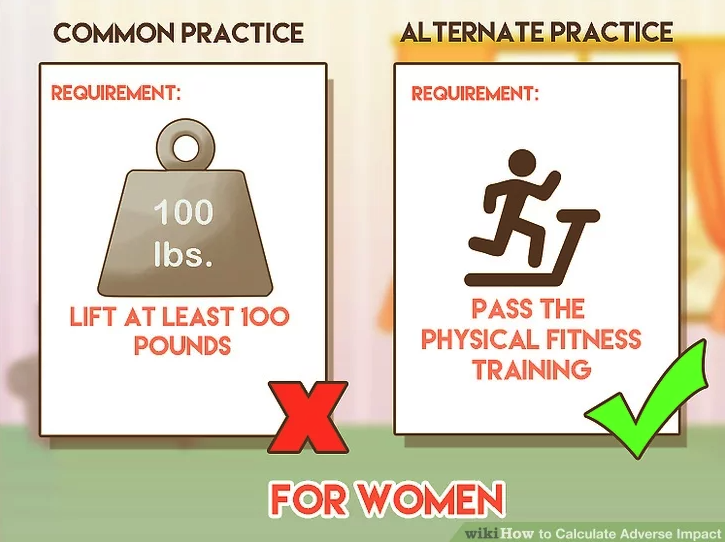
When setting requirements for your vacancy, consider if they can have adverse impact on protected groups and come up with alternate selection practice. (Source: WikiHow)
2. Understand the four-fifths rule
Following the 4/5 rule is an excellent way to determine if adverse impact exists in your candidate selection procedures. According to the Uniform Guidelines on Employee Selection Procedures, the four-fifths rule states:
“A selection rate for any race, sex, or ethnic group which is less than four-fifths (4/5) or eighty percent of the rate for the group with the highest rate will generally be regarded by the Federal enforcement agencies as evidence of adverse impact, while a greater than four-fifths rate will generally not be regarded by Federal enforcement agencies as evidence of adverse impact.”
In other words, the selection rate of protected groups should be 80% of the selection rate of non-protected groups to avoid adverse impact against minority applicants.
To check for adverse impact under the four-fifths rule, calculate the selection rate (the number of candidates selected divided by the total number of applicants) for each group that makes up >2% of the applicant pool. Then, determine which group has the highest selection rate and divide that by the selection rate of the other groups to determine if there are substantial differences.
Here’s an example of how to check for adverse impact from SHRM:

3. Track your applications and pass rates
Another great way to minimize adverse impact is to keep track of your applications and pass rates. Learn what you can about audiences of the websites where you advertise your job openings and ask the right questions through a voluntary EEO survey. Are you trying to get your job ads in front of a sufficiently diverse audience in terms of gender, race, and age? Are you getting applications from diverse groups of people?
Then you can look into how the applicants are doing at each stage of the recruitment funnel and use the 80% rule to screen for adverse impact. If you find out that significantly fewer applicants of a certain protected group make it further in the recruitment process, do some digging to figure out why. Use the information on candidates’ characteristics purely for the sake of transparency.
The state of diversity recruiting in 2020
4. Inspect your pre-employment assessments
You also need to inspect your pre-employment assessments and their validity to perform an adverse impact analysis. There are three different types of validity:
- Criterion-related validity is the extent to which test scores relate to the relevant criterion, which is usually defined as a measure of job performance.
- Content validity is the extent to which the test material is representative of the construct it’s measuring, or ability to do the job.
- Construct validity is the accumulation of evidence that a test is based on sound psychological theories.
For cognitive ability testing, use assessments that are light on language and tested on a diverse group to be sure they’re not racially or ethnically discriminatory. You can also combine selection methods by using different types of assessments to evaluate candidates. In fact, having a single screening method can have a negative impact on your organization’s ability to develop a diverse and inclusive workforce.
For example, Situational Judgement Tests (SJT) are very effective because they allow you to see how applicants would respond in a number of different real-life work situations and usually have lower levels of adverse impact. Ask your assessment vendor about the different forms of testing offered and monitor the tools’ performance regularly.
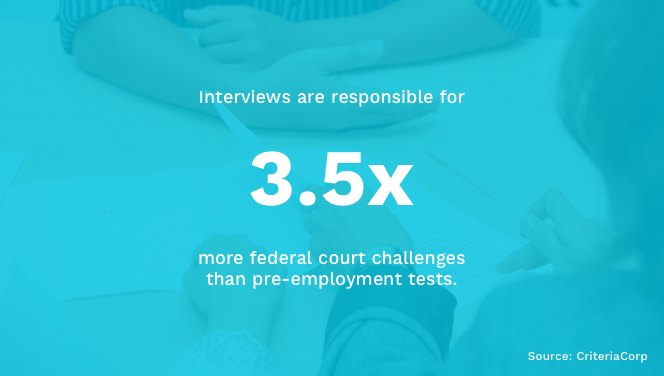
Even though interviews are the more ‘tricky’ part of candidate selection in legal terms, there’s still need to check for adverse impact in pre-employment assessments.
5. Train your team on best practices
To truly minimize adverse impact on your recruitment practices, you have to make sure the whole team is on board. That’s why it’s important to train your team—especially hiring managers and leadership—on the best practices to mitigate adverse impact.
You can do this effectively by teaching team members about unconscious hiring bias and how to prevent it, as well as keeping them up-to-date on employment laws. Additionally, you can help improve their interview skills and make sure you have a clear, standardized process in place to minimize potential adverse impact during this stage.
6. Document your hiring processes
Make it a point to carefully document your hiring processes: applicants you had, why you shortlisted and hired certain applicants and not others, what employee selection methods you used in the process, who was the decision-maker, and so on. The same goes when it comes to awarding promotions, raising wages, initiating transfers, and laying off employees.
By taking the time to document your hiring, promotion, and layoff processes, you can ensure you have a paper trail in place to protect your organization against potential lawsuits and discrimination claims. Plus, keeping track of your processes will help you keep a close eye on what you’re doing to make continuous improvements over time.
7. Monitor your current workforce
It’s also a smart practice to monitor your workforce and conduct validation research to confirm that the applicants who perform well during your pre-employment assessments are the same individuals who go on to perform well in their subsequent roles.
Doing so will help you make sure you’re assessing relevant, job-related criteria. It will also help you pinpoint potential adverse impact in situations where assessment and on-the-job performance don’t line up the way you’d expect. Then you can adapt your selection processes and make improvements to ensure they’re not discriminatory.
8. Avoid discrimination in layoffs
If you need to conduct layoffs in the light of the COVID-19 pandemic or any other reasons, it’s important to take the appropriate steps to ensure that no protected groups are disproportionately impacted. For example, are older employees or those with disabilities being laid off at a higher rate than younger or more able-bodied individuals? Carefully review your layoff and termination processes to determine if it will result in any disparate dismissal of any group protected by employment discrimination laws.
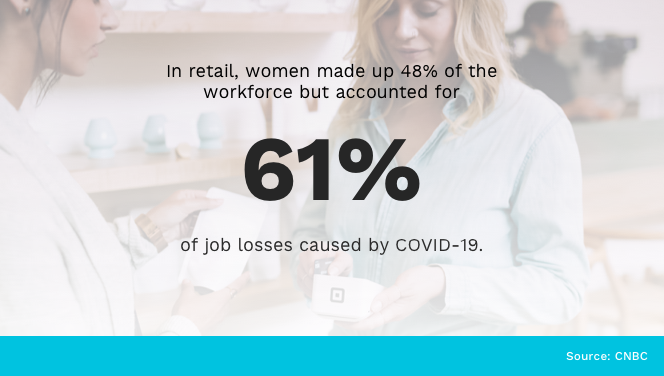
When you find out that job losses at your organization disproportionately affect a certain protected group, check for adverse impact in your layoff practices.
What comes next?
Now you’re probably wondering what next steps you should take to minimize adverse impact in your hiring practices. Here’s some food for thought: Consider setting up a process to monitor adverse impact in your company’s hiring processes throughout the entire recruitment funnel, from the initial job posting to when the person already works for you. This will allow you to constantly improve your recruitment efforts and ensure fair hiring and employment practices across the board.
The state of diversity recruiting in 2020

